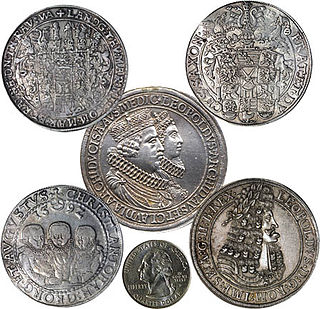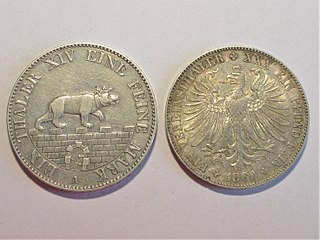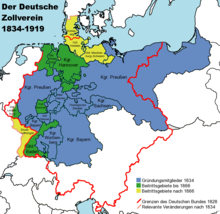
A thaler or taler is one of the large silver coins minted in the states and territories of the Holy Roman Empire and the Habsburg monarchy during the Early Modern period. A thaler size silver coin has a diameter of about 40 mm and a weight of about 25 to 30 grams. The word is shortened from Joachimsthaler, the original thaler coin minted in Joachimsthal, Bohemia, from 1520.

One of the functions of the North German Confederation was to handle the mail and issue postage stamps, which it began doing, by means of the North German Postal Union (Norddeutscher Postbezirk), on 1 January 1868.

The German mark was the currency of the German Empire, which spanned from 1871 to 1918. The mark was paired with the minor unit of the pfennig (₰); 100 pfennigs were equivalent to 1 mark. The mark was on the gold standard from 1871 to 1914, but like most nations during World War I, the German Empire removed the gold backing in August 1914, and gold coins ceased to circulate.

The Vereinsthaler was a standard silver coin used in most German states and the Austrian Empire in the years before German unification.

The Conventionstaler or Konventionstaler, was a standard silver coin in the Austrian Empire and the southern German states of the Holy Roman Empire from the mid-18th to early 19th-centuries. Its most famous example is the Maria Theresa thaler which is still minted today. The Conventionsgulden was equivalent to a 1⁄2Conventionsthaler.

The Reichsthaler, or more specifically the Reichsthaler specie, was a standard thaler silver coin introduced by the Holy Roman Empire in 1566 for use in all German states, minted in various versions for the next 300 years, and containing 25–26 grams fine silver.
The South German Gulden was the currency of the states of Southern Germany between 1754 and 1873. These states included Bavaria, Baden, Württemberg, Frankfurt and Hohenzollern. It was divided into 60 kreuzer, with each kreuzer worth 4 pfennig or 8 heller.

Bavaria used the South German gulden as its currency until 1873. Between 1754 and 1837 it was a unit of account, worth 5⁄12 of a Conventionsthaler, used to denominate banknotes but not issued as a coin. The Gulden was worth 50 Conventionskreuzer or 60 Kreuzer Landmünze.

Baden used the South German gulden as its currency from 1754 until 1873. Until 1821, the Gulden was a unit of account, worth 5⁄12 of a Conventionsthaler, used to denominate banknotes but not issued as a coin. It was subdivided into 50 Conventionskreuzer or 60 Kreuzer landmünze.
Events from the year 1873 in Germany.
The Vienna Monetary Treaty of 1857 was a treaty that set a currency standard for use across the German Zollverein states, Austria, and Liechtenstein. The official name of the treaty was Monetary Treaty Between the German States of 24 January 1857.
The North German Confederation Treaty was the treaty between the Kingdom of Prussia and other northern and central German states that initially created the North German Confederation, which was the forerunner to the German Empire. This treaty, and others that followed in September and October, are often described as the August treaties, although not all of them were concluded in August 1866.

The Munich Coinage Treaty of 1837 was a treaty between six southern German states who agreed to form the South German Coinage Union and to unify their currencies together with some of the central German states. The Munich Coinage Treaty was updated by the South German Coinage Convention of 1845. The agreement is less commonly known as the Munich Coin Treaty.
The Steuerverein was formed in 1834 as a customs union first of the Duchy of Brunswick and the Kingdom of Hanover and then with the Grand Duchy of Oldenburg in 1836. Hanover joined the Deutscher Zollverein in 1854, after negotiating advantageous conditions with Prussia.
The North German thaler was a currency used by several states of Northern Germany from 1690 to 1873, first under the Holy Roman Empire, then by the German Confederation. Originally equal to the Reichsthaler specie or silver coin from 1566 until the Kipper und Wipper crisis of 1618, a thaler currency unit worth less than the Reichsthaler specie was first defined in 1667 and became widely used after adoption of the Leipzig currency standard of 1690.

The history of Saxon coinage or Meissen-Saxon coinage comprises three major periods: the high medieval regional pfennig period, the late medieval pfennig period and the thaler period, which ended with the introduction of the mark in 1871/72. Rich silver deposits, which were discovered near Freiberg after the middle of the 12th century, helped Saxony to a leading position in German coinage.

A Konventionsfuß was a coinage standard established by state treaty, the convention. The first one was between Austria and a number of German states of the Holy Roman Empire in the mid-18th century. This Convention determined that 20 gulden or 10 Speziesthaler be minted from a single Cologne mark of fine silver. Since the Cologne mark weighed approximately 233 g, one gulden had a fine weight of 11.69 g of silver.

A coin base weight (Münzgrundgewicht) is a mathematical reference for the minting of coins that was used in the monetary systems of the Holy Roman Empire. In conjunction with the coin standard (Münzfuß), the coin base weight indicates how many coins are to be minted from a specified standard weight.

The Prussian-Hessian Customs Union was a customs union between the Kingdom of Prussia and the Grand Duchy of Hesse that was established in 1828. Several other states joined over the following years, most notably the Electorate of Hesse. The union was an important stepping stone towards the creation of the German Custom Union, which replaced it in 1834, and thus a first economic step towards the unification of Germany.

The Central German Commercial Union was a customs union created in 1828 by several small states within the German Confederation. It was formed in response to the creation of the Prussian-Hessian Customs Union, and was intended as an alternative to a union dominated by the Kingdom of Prussia. The key proponent of the union was the Kingdom of Saxony and most of the smaller states of Northern Germany were initially members, but the union failed to implement any concrete measures and was a dead letter by 1833. Most members joined the Prussian-led German Zollverein in 1834.













